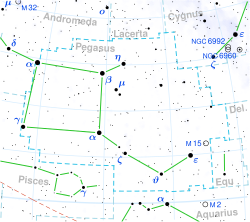
Back HD 209458 Afrikaans HD 209458 German HD 209458 Spanish اچدی ۲۰۹۴۵۸ Persian HD 209458 Finnish HD 209458 French HD 209458 Italian ペガスス座V376星 Japanese HD 209458 Korean HD 209458 LB
| Observation data Epoch J2000 Equinox J2000 | |
|---|---|
| Constellation | Pegasus |
| Right ascension | 22h 03m 10.77275s[1] |
| Declination | +18° 53′ 03.5494″[1] |
| Apparent magnitude (V) | 7.65[2] |
| Characteristics | |
| Evolutionary stage | main sequence |
| Spectral type | F9 V[3] or G0 V[4] |
| Apparent magnitude (B) | 8.244[2] |
| Apparent magnitude (K) | 6.308±0.026[2] |
| B−V color index | +0.574±0.014[5] |
| Variable type | EP[6] |
| Astrometry | |
| Radial velocity (Rv) | −14.78±0.16[1] km/s |
| Proper motion (μ) | RA: 29.766(28) mas/yr[1] Dec.: −17.976(25) mas/yr[1] |
| Parallax (π) | 20.7694 ± 0.0266 mas[1] |
| Distance | 157.0 ± 0.2 ly (48.15 ± 0.06 pc) |
| Absolute magnitude (MV) | 4.28±0.10[5] |
| Details | |
| Mass | 1.148±0.022[7] M☉ |
| Radius | 1.203±0.061[7] R☉ |
| Luminosity | 1.77±0.14[7] L☉ |
| Temperature | 6071±20[7] K |
| Metallicity [Fe/H] | 0.00±0.02[5] dex |
| Rotation | 14.4 days[citation needed] |
| Rotational velocity (v sin i) | 4.228±0.007[8] km/s |
| Age | 3.5±1.4[7] Gyr |
| Other designations | |
| Database references | |
| SIMBAD | data |
| Exoplanet Archive | data |

HD 209458 is a star with an orbiting exoplanet in the constellation Pegasus. It has an apparent visual magnitude of 7.65[2] and an absolute magnitude of 4.28.[5] Because it is located at a distance of 157 light-years (48 parsecs) from the Sun as measured via parallax, it is not visible to the unaided eye. With good binoculars or a small telescope it should be easily detectable. The system is drifting closer with a heliocentric radial velocity of −14.8 km/s.[1]
The spectrum of HD 209458 presents as a late F- or early G-type main-sequence star with a stellar classification of F9 V[3] or G0 V,[4] respectively. It is roughly 3.5[7] billion years old and is spinning with a projected rotational velocity of 4.2 km/s.[8] The star displays a moderate amount of magnetic activity in its chromosphere.[10] It has a 15% greater mass than the Sun and a 20% larger radius. The abundance of iron, a measure of the metallicity of the star, is solar.[7] HD 209458 is radiating 1.8 times the luminosity of the Sun from its photosphere at an effective temperature of 6,071 K.[7]
Because the planet transits the star, the star is dimmed by about 2% every 3.5 days making it an extrinsic variable. The variable star designation for HD 209458 is V376 Pegasi. It is the prototype of the variable class "EP" in the General Catalogue of Variable Stars, defined as stars showing eclipses by their planets.[6][11]
- ^ a b c d e f Cite error: The named reference
GaiaDR3was invoked but never defined (see the help page). - ^ a b c d Cite error: The named reference
Anderson_Francis_2012was invoked but never defined (see the help page). - ^ a b Cite error: The named reference
Gray_et_al_2001was invoked but never defined (see the help page). - ^ a b Cite error: The named reference
Charbonneau2000was invoked but never defined (see the help page). - ^ a b c d Cite error: The named reference
mazehwas invoked but never defined (see the help page). - ^ a b Cite error: The named reference
gcvswas invoked but never defined (see the help page). - ^ a b c d e f g h Cite error: The named reference
Del Burgo2016was invoked but never defined (see the help page). - ^ a b Cite error: The named reference
Bonomo2017was invoked but never defined (see the help page). - ^ Cite error: The named reference
SIMBADwas invoked but never defined (see the help page). - ^ Cite error: The named reference
Ben-Jaffel_2007was invoked but never defined (see the help page). - ^ Samus, N. N. (2009). "GCVS Variability Types and Distribution Statistics of Designated Variable Stars According to their Types of Variability". Retrieved 2010-08-02.
© MMXXIII Rich X Search. We shall prevail. All rights reserved. Rich X Search
